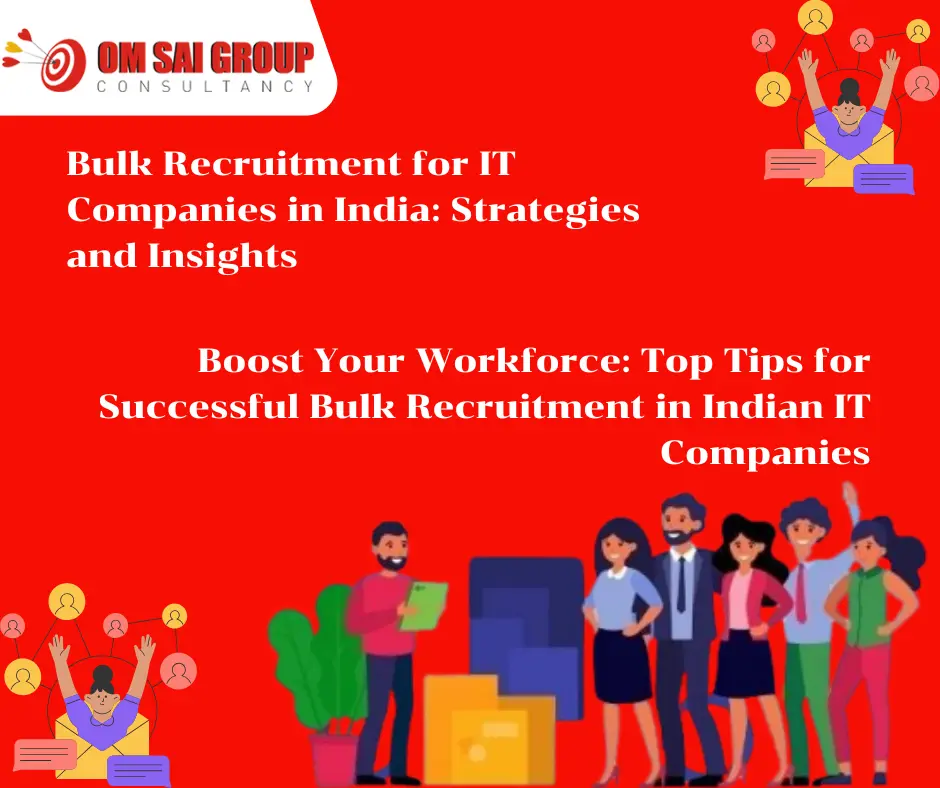

Bulk recruitment for IT companies in India
The Indian IT sector has long been a cornerstone of the nation’s economic growth, contributing approximately 7.7% to the country’s GDP in FY2023. With a projected growth rate of 8.4% annually, this industry shows no signs of slowing down. Bulk recruitment for IT companies in India
As companies scale, particularly in response to digital transformation demands, they face challenges in acquiring skilled professionals at the required pace. According to a NASSCOM report, the IT industry had over 1.4 million open positions in 2023 alone, reflecting the significant mismatch between supply and demand. The solution.
Time Constraints: IT projects often operate on tight timelines. Delays in hiring can jeopardize project deadlines and impact client satisfaction.
Cost Implications: A report by the Society for Human Resource Management (SHRM) states that the average cost per hire for IT roles is approximately ₹1.25 lakh. For bulk hiring, inefficiencies in the process can exponentially increase this expense.
Quality Compromise: Rushed recruitment can lead to poor hiring decisions, affecting project outcomes and team dynamics.
Retention Issues: High attrition rates—hovering at around 21% in the Indian IT sector—compound the problem, creating a vicious cycle of hiring and retraining.
Companies that fail to address these issues risk operational inefficiencies, strained client relationships, and a tarnished reputation.
Bulk recruitment—hiring a large number of employees within a short timeframe—requires a blend of strategic planning, innovative sourcing techniques, and robust assessment methods. Let’s explore the key components of successful bulk recruitment in the Indian IT context.
Campus Recruitment Drives
Campus placements have been a cornerstone of bulk recruitment for decades. By partnering with educational institutions, companies gain early access to a pipeline of fresh talent.
Case Study: Infosys has consistently leveraged campus recruitment to meet its bulk hiring needs. In 2022, the company hired over 50,000 fresh graduates, primarily through collaborations with engineering colleges.
Collaborate with Tier-1, Tier-2, and Tier-3 colleges to diversify the talent pool.
Conduct hackathons and coding competitions to identify high-potential candidates.
Offer internship-to-placement programs for smoother onboarding.
Automation and AI-powered tools are transforming the recruitment landscape, enabling companies to scale their hiring efforts without compromising on quality.
Case Study: TCS Tata Consultancy Services utilizes its proprietary National Qualifier Test (NQT) to streamline bulk recruitment. This online test assesses candidates on aptitude, programming skills, and domain knowledge, significantly reducing the time spent on initial screening.
Use applicant tracking systems (ATS) to manage large volumes of applications.
Implement AI-driven assessment tools for unbiased evaluations.
Deploy chatbots for initial candidate interactions and query resolution.
Referrals are an often-underutilized channel for bulk recruitment. Encouraging employees to refer candidates not only speeds up the process but also improves the quality of hires.
Case Study: Wipro Wipro’s referral program has been instrumental in its recruitment strategy. The company offers monetary rewards and recognition to employees who successfully refer candidates. This approach led to a 30% increase in referral-based hires in 2023.
Introduce tiered rewards to incentivize high-quality referrals.
Use internal communication channels to promote the program.
Provide regular updates on referral status to maintain employee engagement.
For companies scaling rapidly, outsourcing parts of the recruitment process can be a viable solution. RPO providers bring expertise, technology, and scalability to the table.
Case Study: Cognizant partnered with an RPO provider to handle its bulk recruitment needs during a massive expansion phase. The provider managed end-to-end recruitment, from sourcing to onboarding, enabling Cognizant to focus on strategic initiatives.
Best Practices:
Choose RPO partners with expertise in IT hiring.
Clearly define KPIs and SLAs to ensure alignment.
Regularly review performance metrics for continuous improvement.
Given the rapid evolution of technology, upskilling and reskilling have become critical components of bulk recruitment strategies.
Case Study: HCL Technologies HCL’s TechBiz program targets high school graduates, offering them specialized training in IT skills before integrating them into projects. This approach addresses skill gaps while expanding the talent pool.
Best Practices:
Partner with online learning platforms like Coursera and Udemy.
Offer bootcamp-style training for niche skills like AI, ML, and cybersecurity.
Create internal certification programs to validate skill acquisition.
The effectiveness of bulk recruitment efforts can be evaluated using the following metrics:
Time-to-Hire: Measures the average time taken to fill a position.
Cost-per-Hire: Tracks the total expense incurred for each hire.
Offer Acceptance Rate: Indicates the percentage of candidates who accept job offers.
Attrition Rate: Reflects employee turnover within a specific period.
Diversity Metrics: Ensures a balanced and inclusive workforce.
IT companies in India Despite its benefits, bulk recruitment comes with challenges. Here’s how companies can address them:
High Dropout Rates:
Solution: Engage candidates through regular communication and pre-joining programs.
Skill Mismatches:
Solution: Use targeted assessments and detailed job descriptions to align expectations.
Scaling Onboarding Processes:
Solution: Automate onboarding through HR software and provide virtual training modules.
Maintaining Employer Brand:
Solution: Highlight employee success stories and offer competitive benefits.
As the IT industry continues to evolve, bulk recruitment strategies must adapt. Emerging trends include:
Hyper-Personalization: Tailoring recruitment experiences for candidates using AI and data analytics.
Gig Workforce Integration: Leveraging freelancers and contractual workers to address short-term needs.
Focus on Soft Skills: Increasing emphasis on communication, teamwork, and adaptability.
5 Brilliant Ways To Use Global Recruitment Services Breaking Down Borders The contemporary corporate world…
How To Make Your Product Stand Out With a Global Recruitment Agency Unlocking the Power…
How to Choose the Best Dubai Recruitment Agencies The Growing Need for Trusted Recruitment Partners…
7 Benefits of Using a Recruitment Consultancy in Bangalore Unlocking the Hiring Challenges Bangalore’s Market…
2 Ways You Can Use Top 10 Consultancy in Mumbai The Power of Consultancy in…
3 Ways To Master Top 10 Gulf Recruitment Agencies in Mumbai Unlocking Doors to Boundless…